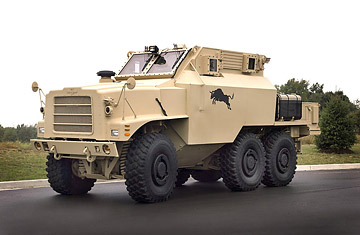
The Bull MRAP II vehicle.
Late each weekday afternoon, the Pentagon issues a list of all the contracts it has awarded that day. Last Thursday, well down on the roster, was a trio of contracts to three companies for more than $1 billion to buy 2,400 Mine-Resistant Ambush Protected vehicles for U.S. troops in Iraq. There is no doubt such heavy-duty vehicles are needed. Improvised-explosive devices account for more than half the U.S. fatalities in Iraq; and the characteristic V-shaped hulls of these vehicles are engineered to deflect blasts from roadside bombs away from the troops within. So the push is on to get the MRAPs to Iraq as quickly as possible. The 2,400 the Marines bought Thursday will be delivered by April — at the speed of light, in Pentagon contracting terms.
The U.S. military is currently paying about $130,000 apiece in shipping costs to get the MRAPs (stickered at $800,000 each) to Iraq via commercial and military cargo planes. There are already nearly 500 MRAPs in Iraq, with a goal of 1,500 by year's end. Currently, about 10 a day are being shipped. "We continue to get as many to theater as rapidly as we can so that optimally every Marine, some day, will be riding... in an MRAP-type of vehicle," Marine General James Conway said last Monday. "To date, we have lost no Marines or sailors in the al Anbar province to underbody explosions when they were riding in the MRAP."
But the push to encase as many U.S. troops as possible in MRAPs is raising some vexing questions. Because there are so many suppliers and different designs, the Pentagon is buying 16 different kinds of MRAPs, each with its own requirements for maintenance, training and spare parts. The MRAPs, up to five times as heavy as the Humvees they are replacing, gulp a lot more fuel — fuel that gets to them inside thin-skinned tanker trucks that must travel Iraq's IED-laden roads.
Beyond that, the notion of sealing troops in metal cocoons is contrary to the Pentagon's notion of counter-insurgency warfare, which requires soldiers and Marines to mingle with the local population they are trying to win over. Winning hearts and minds in Iraq demands "close contact with the local population to provide them with security and to develop a working knowledge of the local environment that, together, produces the intelligence necessary to defeat an insurgent enemy force," a respected military think tank said in report released October 17. "The MRAP — at least in this situation — may send the wrong message to troops in the field," says the study from the Center for Strategic and Budgetary Assessments.
But it's not only retired ground-pounder officers like Andrew Krepinevich and Dakota Woods — who wrote the CSBA study — who are concerned. Conway, the Marine commandant, also said last week that while there is no questioning the imperative for MRAPs in Iraq, he wonders if their purchase will change the Marines' traditional agile and expeditionary nature. He basically shrugged his shoulders over the question of how useful the 8,800 MRAPs now on order will be after Iraq. "Can I give a satisfactory answer to what we're going to be doing with those things in five or 10 years? Probably not," the Marines' top officer said. "Wrap them in shrink wrap and put them in asphalt somewhere is about the best thing that we can describe at this point. And as expensive as they are, that is probably not a good use of the taxpayers' money."
Even in Iraq, there's a question of how well the new vehicles will protect against the growing threat posed by explosively formed penetrators, a new and insidious type of roadside bomb that Iraqi insurgents — allegedly with help from some forces inside neighboring Iran — are using more frequently against U.S. vehicles. An EFP uses an explosive charge to send a molten slug of copper through even the thickest armor. "If the use of EFPs becomes widespread," the CSBA report warns, "any advantage the MRAPs have against earlier forms of IEDs may be irrelevant."
